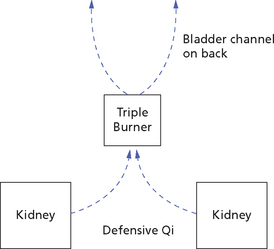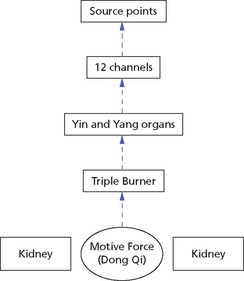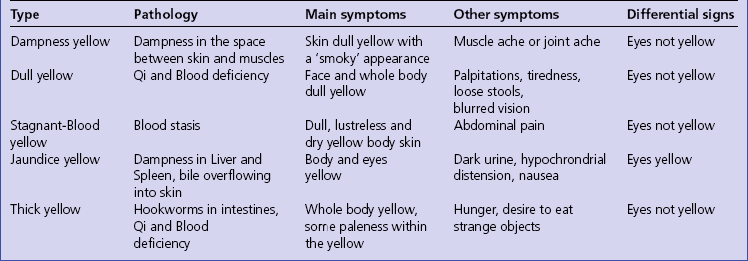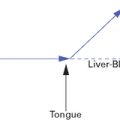 OBSERVATION OF THE SKIN
OBSERVATION OF THE SKIN
INTRODUCTION
Skin layers
Fu indicates the superficial layer of skin (i.e. the epidermis), which is influenced mostly by the Lungs. Ge indicates the deep layer of skin (i.e. the dermis), which is influenced by the Lungs, Liver and Kidneys. Ji, a word that is sometimes translated as “flesh”, indicates the subcutaneous muscles and this structure is influenced by the Spleen and Liver. Fen Rou indicates two structures, i.e. fat (influenced by the Spleen, Kidneys and Directing Vessel) and muscles near the bones (influenced by the Spleen and Liver). Cou Li (therefore, the space between skin and muscles) is influenced by the Lungs and Spleen.1 Xuan Fu are the pores (including the sebaceous glands) through which the sweat comes out and they are influenced by the Lungs and Spleen.
Box 21.1 summarizes the organs influencing each layer of the skin.
Types of skin lesion
Figure 21.1 shows the various types of skin lesions.
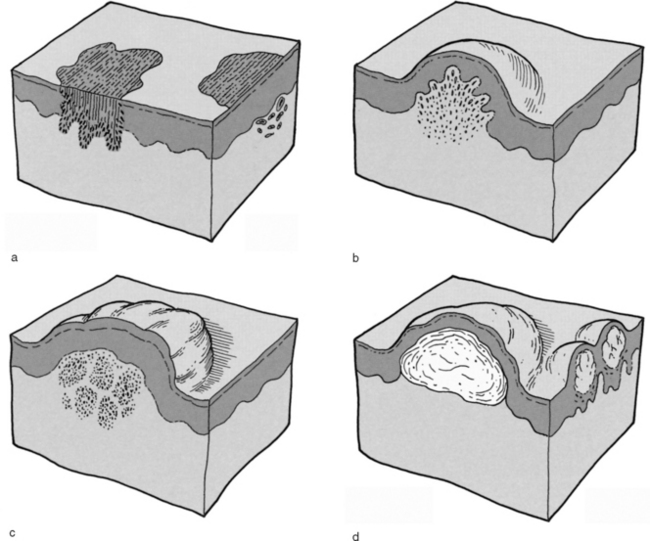
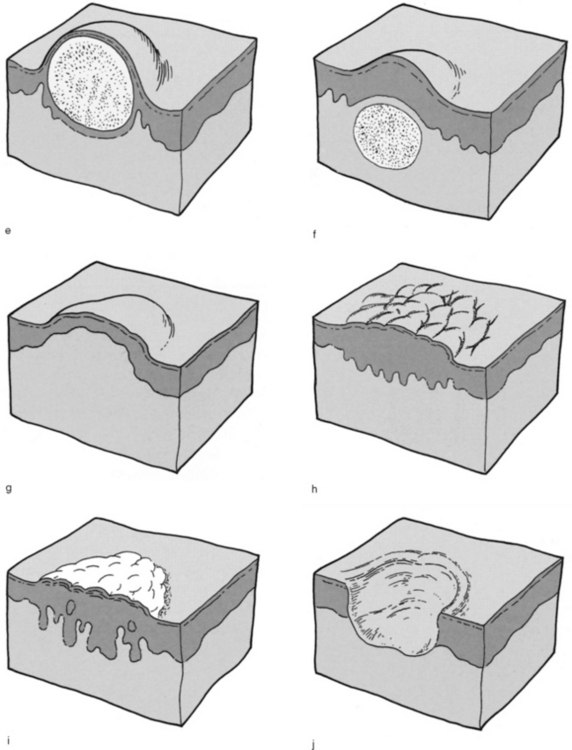
Fig. 21.1 Skin lesions. a, Freckle; b, papule; c, dermatofibroma; d, vesicles; e, pustule; f, epidermal cyst; g, wheal; h, psoriasis plaque; i, white and silvery scale; j, ulcer (From Gawkrodger 1992, An Illustrated Colour Text of Dermatology, pp. 12–13, with permission of Churchill Livingstone.) Churchill Livingstone
THE SKIN AND THE INTERNAL ORGANS
The skin and the Lungs
As a whole, the skin is influenced by the Lungs. Chapter 10 of the “Simple Questions” says: “The Lungs are connected to the skin and control the state of the body hair”.2 The Lungs also control the opening and closing of the pores and this function is related to the Lung’s diffusing of Defensive Qi to the skin. The pores were called “sweat holes” (Han Kong) and their function is to discharge turbid Qi and sweat. The Defensive Qi and, therefore, the Lung’s opening and closing of the pores, is a manifestation of the protective function of the Defensive Qi against the invasion of pathogenic factors. When the Defensive Qi is properly regulated, the pores are closed on exposure to a pathogenic factor and properly open during exercise or on exposure to hot weather. A weakness of Lung-Qi and of the Defensive Qi may lead to “flaccidity” of the pores and result in their being too open: this facilitates the invasion of pathogenic factors. In pathology, a weakness of Lung-Qi, and therefore of the Defensive Qi in the space between the skin and muscles, causes acute skin diseases due to invasion of external Wind such as urticaria.
The skin and the Kidneys
The Kidneys also influence the skin in other ways. First of all, although the Lungs diffuse Defensive Qi, and the Stomach and Spleen contribute to Defensive Qi’s production, the Defensive Qi stems from the Lower Burner and from the Kidneys. Defensive Qi is Yang in nature and it is therefore influenced by Kidney-Yang and the Fire of the Gate of Life. The Kidneys also play an important role in the distribution of Defensive Qi to all other channels and parts of the body with the aid of the Triple Burner and the Bladder channel. The Back Transporting points where the Defensive Qi infuses to the Internal Organs are situated in the back along the Bladder channel. This is because the Defensive Qi emerges from the Kidneys, through the Triple Burner, and flows up along the Bladder channel. Moreover, when the Defensive Qi emerges in the morning after flowing in the Yin organs at night, it starts from the Kidney channel (Chapter 76 of the “Spiritual Axis”)3 (Fig. 21.2).
The Triple Burner also influences the skin and, in particular, the skin’s moisture, because it plays such an important role in the metabolism of fluids. One important aspect of the Triple Burner, in fact, is the diffusion of fluids in the Upper Burner, the separation and transformation of fluids in the Middle Burner and the excretion of fluids in the Lower Burner. As heat is needed to transform and excrete fluids, the Triple Burner relies on that derived from the Fire of the Gate of Life in between the Kidneys. From this point of view, the Triple Burner’s function of transporting and excreting fluids is inseparable from its location between the Kidneys where the Fire of the Gate of Life resides. For this reason, the Triple Burner is closely related to the Original Qi.
Chapter 66 of the “Classic of Difficulties” states:
The Motive Force (Dong Qi) that resides between the Kidneys below the umbilicus is the source of life (ming) and the root of the twelve channels and that is why it is called Original [Qi]. The Triple Burner is the emissary of the Original Qi.4 It penetrates through the three Burners and spreads to the five Yin and the six Yang organs. Original Qi is the honorary name for the Triple Burner and that is why the places where [the Qi of the Triple Burner] stops in turn are called Origin [Source] points. Therefore diseases of the five Yin and the six Yang organs can be reflected on the Origin [Source] points.5
As the Original Qi, which resides between the Kidneys, is the basis for the Triple Burner and transforms fluids that affect the skin, this is another way in which the Kidneys influence the skin (Fig. 21.3).
Chapter 47 of the “Spiritual Axis” illustrates the connection between the skin and the Kidneys and Triple Burner: “The Kidneys are connected with the Triple Burner and the Bladder which influence the pores and body hair”.6 Another passage from Chapter 64 of the “Simple Questions” also illustrates the relationship between the Kidneys and the skin: “When there is a pathogenic factor in the Kidneys, the skin is affected and there is a rash.”7
The skin and the Connecting channels
Chapter 17 of the “Spiritual Axis” says: “The Main channels are in the Interior, their branches are horizontal [or crosswise] forming the Luo channels: branching out from these are the Minute Luo. When these are Full with stagnant Blood they should be drained with bleeding with needle; when they are deficient, they should be tonified with herbs”.8 Chapter 10 of the same book says: “The Main channels are deep and hidden between the muscles and cannot be seen; only the Spleen channel can be seen as it emerges from above the internal malleolus and it has no place to hide. The Luo channels are superficial and can be seen.”9 The same chapter also says: “When the Luo channels are greenish-bluish it indicates Cold and pain; when they are red it indicates Heat.”10
SKIN SIGNS
Skin colour
“Skin colour” refers to the colour of the body skin itself, as distinct from the complexion (discussed in Chapter 3). It does not refer to skin rashes, which will be discussed separately. The colours discussed are:
Of course, when observing body-skin colour one should take into account individual variations due to race and occupation. This has already been discussed in Chapter 3 dealing with observation of the complexion. For example, a body skin that might be described as “pale” in a Mediterranean person would be normal in a Swedish person. Generally speaking, the colours described below apply to any racial group: for example, the body skin of an African-American or an Indian may be pale in colour, like a Caucasian’s, although it will obviously look different.
Skin texture
Apart from the colour, other aspects of the skin should be considered:
Lustre
Lustre in relation to the skin has already been described in the chapter on Complexion (Chapter 3). A body skin with lustre indicates a good state of Body Fluids and of the Lungs, Stomach and Liver.
The space between skin and muscles (Cou Li)
The space between the skin and muscles, called Cou Li, is where the Defensive Qi flows and where sweat comes from.11 The state of the space can be deduced by observing the state of the pores, sweat and skin texture. One should differentiate between a state of openness or closure and one of looseness or tightness.
Macules, papules, vesicles and pustules
Macules
Yin macules start gradually and are not associated with an external origin or a febrile disease: they are generally due either to chronic Blood-Heat or to Qi deficiency.
As for the colour, one should differentiate the following colours of macules:
Purple macules
Purple macules indicate Blood-Heat with Blood stasis. (See Plates 21.1 and 21.2 on p. P9.)
Papules
A wheal, called Feng Tuan in Chinese, is a type of papule (although it may also be a plaque) characterized by a transitory, compressible elevation of skin with dermal oedema, red or white in colour. Urticaria is a typical example of skin eruptions with wheals. Pale wheals are caused by invasion of Wind-Cold or Yang deficiency; red wheals are caused by Heat or Empty-Heat; dark, purple wheals indicate Blood stasis. (See Plate 21.3 on p. P9).
A plaque, in Chinese called Ban, is a type of papule: it is a palpable, plateau-like elevation of skin, usu-ally more than 2 cm in diameter. Certain psoriasis lesions are typical examples of plaques. The clinical significance of plaques is the same as that of papules, that is, red plaques signify Heat while dark ones indicate Heat with Blood stasis. The fact that the Chinese name for plaques is the same as that for macule (Ban) should not induce us to infer that plaques indicate Blood-Heat (as do macules). (See Plate 21.4 on p. P9.)
Vesicles
A vesicle, in Chinese called Shui Pao, is a small blister (usually less than 5 mm in diameter) consisting of clear fluid accumulated within or below the epidermis. A vesicle larger than 5 mm is called a bulla. (See Plate 21.5 on p. P10.)
Table 21.2 differentiates between macules, papules and vesicles.
Swelling of the skin
Observation, Chapter 18; Interrogation, Chapter 39; Symptoms and Signs, Chapter 64
Box 21.6 summarizes the patterns underlying skin oedema.
Scales
A scale, called Lin Xiao in Chinese, is an accumulation of thickened, horny-layer keratin in the form of readily detached fragments. Scales usually indicate an inflammatory change and thickening of the epidermis. They may be fine, as in pityriasis, white and silvery, as in psoriasis, or large and resembling fish scales, as in ichthyosis. (See Plate 21.7 on p. P10.)
Skin ulcers
Western pathology and diagnosis
An ulcer is a circumscribed area of skin loss extending through the epidermis into the dermis. Ulcers are usually the result of impairment of the vascular nutrient supply to the skin, often caused by peripheral arterial disease. Ulcer formation is preceded by itching, pain, erythema, oedema, breakage of the skin and oozing. When the ulcer is formed, there is loss of epidermis; as the ulcer progresses, the opening becomes wider and deeper. (See Plates 21.8 and 21.9 on pp. P10 and P11.)
Dermographism
Dermographism (literally meaning “writing on the skin”) indicates the red wheals that may appear when the skin is stroked with a hard object such as the end of a pencil or a nail. From the Western point of view, this is due to the exaggerated release of histamine from the mast cells in the skin; this occurs in atopic individuals and is due to the presence of abnormal levels of immunoglobulin E (IgE) around the mast cells of the skin. (See Plate 21.10 on p. P11.)
SKIN DISEASES
Eczema
Symptoms and Signs, Chapters 77, 89
Western pathology and diagnosis
It should be remembered that many acute, sudden exacerbations are due to skin infection from Staphylococcus aureus rather than the eczema itself: skin infections in eczema are common as the skin is excoriated and therefore prone to invasion of bacteria. An acute infection is characterized by sudden aggravation of the eczema, papular or pustular rash and pronounced erythema. (See Plates 21.11–21.20 on pp. P11-P13 Plate 21.12 Plate 21.13 Plate 21.14 Plate 21.15 Plate 21.16 Plate 21.17 Plate 21.18 Plate 21.19 Plate 21.20.)
Chinese pathology and diagnosis
Acute eczema is characterized by intense itching, vesicles, erythema (redness), swelling of the skin. Chronic eczema is characterized by itching, erythema, swelling of the skin, crusting, scaling, lichenification (thickening of the skin with increased skin markings), excoriation, and erosion. Chronic eczema may be weeping or dry: weeping eczema indicates the predominance of Dampness, whereas dry eczema indicates the predominance of Heat. However, it should be remembered that in eczema there is always some Dampness as there are always fluid-filled vesicles under the epidermis (which causes the swelling of the skin); when these vesicles come to the surface, the eczema weeps. Furthermore, in atopic dermatitis the superficial stratum corneum of the skin is damaged so that the skin cannot hold moisture properly; this means that the skin becomes dry as a consequence rather than as a cause of the eczema.
Case history 21.1 illustrates a pattern underlying dry eczema.
Box 21.9 summarizes the patterns underlying eczema.
Acne
Observation, Chapter 5; Symptoms and Signs, Chapters 55 and 77
Western pathology and diagnosis
As for the clinical presentation, comedones are either open (blackheads, which are dilated pores with black plugs of melanin-containing keratin) or closed (whiteheads, which are small, cream-coloured, dome-shaped papules). They appear at about the age of 12 years and evolve into inflammatory papules, pustules or cysts. The sites of predilection (face, shoulders, back and upper chest) have many sebaceous glands. The severity of acne depends on its extent and the type of lesion, with cysts being the most destructive. Scars may follow healing especially of cysts. (See Plates 21.21–21.24 on pp. P13 and P14 Plate 21.22 Plate 21.23 Plate 21.24.)
Psoriasis
Symptoms and Signs, Chapter 77
Western pathology and diagnosis
As there are many types of psoriasis, other skin diseases may easily be wrongly diagnosed as psoriasis. Table 21.4 illustrates the differential diagnosis of the most common types of psoriasis (i.e. for each type of psoriasis, the table lists other skin diseases which may look like psoriasis). Although Chinese medicine treats skin diseases primarily according to the presenting pattern and not according to the type of skin disease, in the particular case of psoriasis it is important to differentiate it from other diseases because of its prognosis; psoriasis is usually more difficult to treat. (See Plates 21.25–21.31 on pp. P14-P16 Plate 21.26 Plate 21.27 Plate 21.28 Plate 21.29 Plate 21.30 Plate 21.31.)
Table 21.4
Differential diagnosis of various types of psoriasis
| Type of psoriasis | Differential diagnosis |
| Plaque psoriasis | Psoriasiform drug eruption |
| Palmoplantar psoriasis | Hyperkeratotic eczema, Reiter’s disease |
| Scalp psoriasis | Seborrhoeic dermatitis |
| Guttate psoriasis | Pityriasis rosea |
| Flexural psoriasis | Candidiasis of the flexures |
| Nail psoriasis | Fungal infection of the nails |
Chinese pathology and diagnosis
The patterns causing psoriasis are:
In addition to the above patterns, there is also nearly always Wind in psoriasis. Wind causes intense itching and also dryness: thus, it is important to remember that Dryness is not always a symptom of Blood deficiency.
Box 21.11 summarizes the patterns underlying psoriasis.
Urticaria
Symptoms and Signs, Chapter 77
Western pathology and diagnosis
Urticaria can be acute or chronic. Acute urticaria is typically due to an IgE-mediated type I reaction. The allergen is usually a food (e.g. shellfish or peanuts) or a drug. In some cases urticaria may also be due to insect stings or bites, desensitizing injections or inhalants such as pollen, moulds or animal dander. Some women develop urticaria during menstruation. Acute urticaria normally manifests with a sudden onset of red and very itchy wheals which rapidly spread all over the body. The lesions may be small or may enlarge to as much as 20 cm across. Chronic urticaria is characterized by pale-red or pink itchy wheals which typically last less than 24 hours and disappear without a trace. Often no allergen can be identified. Urticaria may also be caused by exposure to cold, heat or sun. (See Plates 21.32 and 21.33 on p. P16.)
Naevi
Symptoms and Signs, Chapter 77
Western pathology and diagnosis
A differentiation between moles and other types of skin lesions is given in Table 21.5. (See Plate 21.34 on p. P17.)
Table 21.5
| Lesion | Distinguishing features |
| Freckle | Tan-coloured macules on sun-exposed sites |
| Lentigo | Usually multiple with onset in later life |
| Seborrhoeic wart | Stuck-on appearance, warty lesions, easily confused with moles |
| Haemangioma | Vascular but may show pigmentation |
| Dermatofibroma | On legs, firm and pigmented |
| Pigmented, basal cell carcinoma | Often on face, pearly edge, increase in size, may ulcerate |
| Malignant melanoma | Variable colour and outline, increase in size, may be inflamed or itchy |
Malignant melanoma
Tinea
Candida
Symptoms and Signs, Chapter 77
Western pathology and diagnosis
Infections by Candida albicans may affect the following areas:
(See Plates 21.46 and 21.47 on p. P19.)
Chinese pathology and diagnosis
From the Chinese point of view, fungal infections are usually caused by Dampness, which may be combined with either Cold or Heat but more frequently with Heat. Acute fungal infections are usually due to Damp-Heat, whereas chronic fungal infections are characterized by Dampness but they always occur against a background of chronic Spleen-Qi deficiency. Candida infections of the gastrointestinal system often manifest on the tongue with small, peeled patches with a white ring around them and a white-sticky coating in between.
Herpes simplex
Symptoms and Signs, Chapter 77
Western pathology and diagnosis
Recurrent attacks are the hallmark of herpes simplex infection and they occur at a similar site each time, usually on the lips, face or genitals. (See Plates 21.48 and 21.49 on p. P20.) The outbreak of vesicles is often preceded by tingling or burning, crusts form within 48 hours and the infection fades after a week.
Herpes zoster
Symptoms and Signs, Chapter 77
Western pathology and diagnosis
Herpes zoster is an acute vesicular eruption occurring in the dermatomal distribution caused by a recrudescence of the varicella zoster virus. It nearly always occurs in people who have had varicella (chickenpox). Pain, tenderness and tingling in the dermatome precedes the eruption by 3 to 5 days. Erythema and grouped vesicles follow, scattered within the dermatomal area. The vesicles become pustular and then form crusts, which separate in 2 to 3 weeks to leave scarring. Herpes zoster is normally unilateral and two-thirds of patients are over 50 years of age. (See Plate 21.50 on p. P20.)
Chinese pathology and diagnosis
From the Chinese point of view, herpes zoster is also always due to Damp-Heat because of its vesicular and erythematous eruption, but a further differentiation can be made according to the manifestations and location of the lesions. If the lesions are located in the thoracic or hypochondrial region, they are due to Damp-Heat in the Liver and Gall-Bladder channels. Generally speaking, in lesions occurring in the neck and ophthalmic region (which is common in the elderly), in addition to Damp-Heat there is also Wind-Heat. Wind-Heat is also indicated if itching is very intense. If the lesions are pustular, they indicate the presence of Toxic Heat; if they are dark and very painful, they indicate Blood stasis, which also is common in the elderly.
Box 21.17 summarizes the pattern underlying herpes zoster.
Warts
Symptoms and signs, Chapter 77
Western pathology and diagnosis
Common warts present as dome-shaped papules or nodules, usually on the hands or feet. (See Plate 21.51 on p. P20.)
Plane warts are smooth, flat-topped papules often slightly brown in colour, commonest on the face and hands. (See Plate 21.52 on p. P21.)
Plantar warts are seen in children and adolescents on the soles of the feet.
Genital warts affect the penis in males and the vulva and vagina in women. (See Plate 21.53 on p. P21.) The warts present as small papules.
Rosacea
Symptoms and Signs, Chapter 77
Western pathology and diagnosis
Rosacea is a chronic, inflammatory, facial dermatosis characterized by erythema and pustules. The earliest symptom of rosacea is usually flushing of the cheeks which is followed by erythema, telangiectasia (dilated dermal blood vessel), papules and pustules. Rosacea lacks the comedones of acne and occurs in an older age group. (See Plates 21.54 and 21.55 on p. P21.)
NOTES
1. Cou Li ( ) is a difficult term to translate and one that is interpreted differently by modern Chinese doctors. Cou indicates ‘spaces’ or ‘interstices’ and it refers to all the spaces in the body, especially the small spaces (as opposed to large cavities such as the chest and abdomen) all over the body, including the space between skin and muscles, which is probably the most clinically relevant. Li means ‘texture’, ‘grain’ (as in the grain of wood) or ‘pattern’, and it indicates the texture of skin and the Internal Organs: it refers to the organized way in which the skin and organs are arranged, forming a ‘texture’ or ‘pattern’. The ‘Synopsis of Prescriptions from the Golden Cabinet’ says: ‘Cou is the place of the Triple Burner where the Original True [Essence] converges and Qi and Blood concentrate; Li is the texture of the skin and Internal Organs’ (He Ren 1981 A New Explanation of the Synopsis of Prescriptions from the Golden Cabinet Jin Gui Yao Lue Xin Jie
) is a difficult term to translate and one that is interpreted differently by modern Chinese doctors. Cou indicates ‘spaces’ or ‘interstices’ and it refers to all the spaces in the body, especially the small spaces (as opposed to large cavities such as the chest and abdomen) all over the body, including the space between skin and muscles, which is probably the most clinically relevant. Li means ‘texture’, ‘grain’ (as in the grain of wood) or ‘pattern’, and it indicates the texture of skin and the Internal Organs: it refers to the organized way in which the skin and organs are arranged, forming a ‘texture’ or ‘pattern’. The ‘Synopsis of Prescriptions from the Golden Cabinet’ says: ‘Cou is the place of the Triple Burner where the Original True [Essence] converges and Qi and Blood concentrate; Li is the texture of the skin and Internal Organs’ (He Ren 1981 A New Explanation of the Synopsis of Prescriptions from the Golden Cabinet Jin Gui Yao Lue Xin Jie  ), Zhejiang Science Publishing House, Beijingp. 2). I translate Cou Li as ‘space between skin and muscles’. Although this is not strictly accurate, because there are other spaces and because it ignores the Li part of it, it is the most clinically relevant. In the context of skin, therefore, Cou Li is the space between skin and muscles
), Zhejiang Science Publishing House, Beijingp. 2). I translate Cou Li as ‘space between skin and muscles’. Although this is not strictly accurate, because there are other spaces and because it ignores the Li part of it, it is the most clinically relevant. In the context of skin, therefore, Cou Li is the space between skin and muscles
2. The Yellow Emperor’s Classic of Internal Medicine – Simple Questions (Huang Di Nei Jing Su Wen  ). People’s Health Publishing House: Beijing, 1979:70 First published c. 100BC
). People’s Health Publishing House: Beijing, 1979:70 First published c. 100BC
3. Spiritual Axis (Ling Shu Jing  ). People’s Health Publishing House: Beijing, 1981:129 para 139. First published c. 100BC
). People’s Health Publishing House: Beijing, 1981:129 para 139. First published c. 100BC
4. Clavey gives a different interpretation of the words bie shi ( ), which are usually translated as ‘emissary’ or ‘special emissary’. According to him, the words should be translated as ‘makes separate’. In other words, if this interpretation is correct, the Triple Burner separates the undifferentiated Original Qi and directs it into different channels and organs to perform its various functions. I personally feel that this interpretation is probably more correct. (Clavey, S. 1995 Fluid Physiology and Pathology in Traditional Chinese Medicine, Churchill Livingstone, Edinburgh, p. 21. )
), which are usually translated as ‘emissary’ or ‘special emissary’. According to him, the words should be translated as ‘makes separate’. In other words, if this interpretation is correct, the Triple Burner separates the undifferentiated Original Qi and directs it into different channels and organs to perform its various functions. I personally feel that this interpretation is probably more correct. (Clavey, S. 1995 Fluid Physiology and Pathology in Traditional Chinese Medicine, Churchill Livingstone, Edinburgh, p. 21. )
5. Nanjing College of Traditional Chinese Medicine. A Revised Explanation of the Classic of Difficulties (Nan Jing Jiao Shi  ). People’s Health Publishing House: Beijing, 1979:144 First published c. AD100
). People’s Health Publishing House: Beijing, 1979:144 First published c. AD100
11. The term Cou Li actually indicates more complex structures of the body and it includes all ‘spaces’ between organs and between channels: functionally, the Cou Li is connected to the Triple Burner. In this context, I will again translate it as ‘space between skin and muscles’ but the reader should bear in mind that this is only one of the Cou Li ‘spaces’. Furthermore, while cou means ‘spaces’ or ‘interstices’, li means ‘pattern’ or ‘texture’ and it refers to the striae of the Internal Organs. I therefore translate Cou Li as ‘space between skin and muscles’ in the appropriate context, even though this is only one of the meanings of Cou Li. (See also Note 1 above. )

